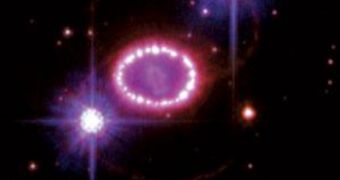Up until this point, astronomers have believed that when a supernova explodes there are only two possible outcomes – either a black hole or a neutron star. However, recent observations have shown that a third possibility also exists. Quark stars are celestial bodies that form when the pressure created by the supernova explosion falls just short of forming a black hole. The neutrons in the star break up into their components, namely quarks, and a new star is born.
The reason why this hypothetical celestial body is so important is because it could offer valuable insight into the early history of the Universe, when everything that was created after the Big Bang “swam” in a see of dense quark matter, at temperatures of approximately a trillion degrees Celsius. Up to this point, no such bodies have been identified, although some groups have claimed that they may have found some candidates. But, scientists share, if mathematical calculations prove their existence, than it's just a matter of time until they are discovered.
One of the strongest candidates for a quark star is the bright supernova called SN 1987A, which is located relatively close to our solar system. University of Hong Kong professor Kwong-Sang Cheng, the one who has discovered the possible new class of celestial bodies, says that neutron stars usually emit a single burst of neutrinos once they are formed, whereas this particular object emits at least two, recorded by various observatories on Earth and in orbit.
In an upcoming issue of The Astrophysical Journal, the Chinese team will detail its readings, obtained via the use of two neutrino detectors, namely Kamiokande II in Japan, and Irvine-Michigan-Brookhaven, in the US. “There is a significant time delay between [the bursts recorded by] these two detectors,” Cheng says. This could be caused by the forming of a neutron star, and then its collapse into a quark star, just seconds later.
“This model is intriguing and reasonable. It can explain many key features of SN 1987A,” Nanjing University researcher Yong-Feng Huang adds. Although the Chinese are very excited about this potentially-groundbreaking find, there are still those who stay calm and hope for the best. “I hope they're right. My first reaction, though, is that this is a bit of a long shot,” Princeton Institute for Advanced Study astronomer Edward Witten concludes.

 14 DAY TRIAL //
14 DAY TRIAL //